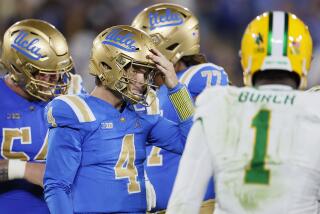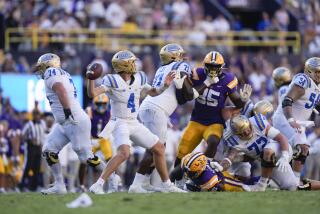At 5-10, He Isn’t Short on Heart : College football: Fullback Ford of Whittier walked out on Nebraska, walked on at UCLA.
There he is, on page 76 of the Nebraska football media guide: Ford, Greg . . . RB . . . 5-10 . . . 235 . . . fr. . . . Whittier, Calif.
And there, on page 30, under “Nebraska Football . . . Coast to Coast Talent.” California. Whittier: Greg Ford.
But there he is, in the Bruin backfield against Southern Methodist, getting a first down on third and one, then leading Sharmon Shah through a hole Saturday night at the Rose Bowl.
Ford was signed and sealed but won’t be delivered to Nebraska as a walk-on fullback until this weekend. Instead, he was rerouted to UCLA, which accidentally discovered the backfield blocker it needed in its own neighborhood and will have him in Lincoln on Saturday.
“If he was 6-3 or 6-4, he’d have--how many Division I schools are there, 106?--offers,” UCLA Coach Terry Donahue said.
“All I know is that he’s getting taller around here.”
Actually, Ford is almost 5 feet 11, 255 pounds. The height alone was considered enough of a flaw to make the 30 or so schools that had sent him letters of inquiry run for cover.
Even when he showed extra quickness and strength as the state high school heavyweight wrestling champion, they stayed underground.
Only Nebraska was interested enough to bring him in for a recruiting visit, but that interest was tempered. There would be no scholarship, but the Cornhuskers would give him a uniform and let him become part of a walk-on tradition that has generated four of this season’s starters and 28 of 80 players on the depth chart.
It was enough for Ford, until UCLA assistant Mike Sherman came along.
Sherman visited Whittier High in June to look at a tackle. At the time, UCLA sought a fullback to supplement the two converted tailbacks--James Milliner and Daron Washington--being used at the position.
“I was watching a high school film of next year’s prospects and saw Greg Ford playing nose guard,” Sherman said.
“I said, ‘He’s a great-effort kid,’ and the coach (Mike Fitch) talked about him, gave him a great recommendation and said he really wasn’t going any place. I asked did he ever play fullback? Then he put another film on a goal-line situation. I saw him move the pile.”
Sherman called Donahue, and they invited Ford to drive over to Westwood. Ford’s mother, Ann, a UCLA alumna, came along. With four brothers who’d played football--one, George Buehler was the Oakland Raider right guard when the left side of the line, Gene Upshaw and Art Shell, was playing its way into the Hall of Fame; another, Jon, was a walk-on at USC, and Chuck played at Stanford--she knew the right questions.
Sherman introduced the Fords to Ed Kazarian, the academic liaison for the football program. Backfield coach Wayne Moses was called in. Then Donahue started selling.
He talked about the walk-ons who had gone on to fame at UCLA, of quarterback Rick Neuheisel, of wide receiver Mike Sherrard. And of the walk-on who stayed longest of all. A tackle, name of Terry Donahue.
It was worth thinking about, and they did for two weeks. A new NCAA rule was the clincher.
“At Nebraska, I wouldn’t be one of the 105,” said Ford. “At UCLA, I would.”
A new rule mandates no more than 105 players--scholarship and walk-on--can practice before school starts. Ford was no closer than 106 at Nebraska.
“He couldn’t have come here until Aug. 22,” said George Darlington, the Nebraska assistant who recruits Southern California. “He was a nice youngster, and we were very disappointed.”
By Aug. 22, Nebraska was well into workouts, and Ford saw a road that was going uphill anyway turning into mountain climb. Donahue helped make that clearer.
“He told me I would be part of the 105 and come in with everyone else at UCLA,” Ford said. “It’s all I wanted. I just wanted an even chance, a shot at playing like everyone else was getting. If I couldn’t play, at least I had the shot.”
He also had more than a little luck.
Because of injuries, only Akil Davis, a 160-pound converted freshman wide receiver, and Ford were available on a scrimmage day, so Davis played tailback, running behind Ford.
For variety, Ford got to carry the ball occasionally.
Washington started getting more time at tailback after that, and Ford got plenty of time at fullback, where he is more of a sixth lineman than a ballcarrier.
“It wasn’t that he didn’t want to carry the ball,” Moses said. “But he’s taken his position and made it the most important on the team to him.”
Jon Ford has helped, too.
He was 16 months older than Greg, 12 when the cancer was found. The brothers had fought and competed while growing up, but when Jon got sick, Greg stayed by his side. Others could play.
“Every day after school, I would be there, talking, watching TV, just messing around,” Greg Ford said. “When he went into the hospital, after my mom got off from work, I would ask her to take me and I would stay, even if it was 1 in the morning.”
When Jon Ford died, Greg Ford was so depressed that he blew up to 240 pounds, over a 5-6 frame. He was a 12-year-old who didn’t like himself. It took years in the gym to fix that.
Jon both inspires him and helps him maintain perspective.
“I think about him all the time,” Ford said. “It’s tough sometimes, but I have good memories. When I think football is tough, I think of him. It’s nothing compared to fighting cancer for six months. I ask him to be with me every game. He’s my strength.”
It’s one of the intangibles that Sherman refers to when he talks of Ford.
“He’s a squatty-body kid,” Sherman said. “It’s hard to justify a recruiting trip for a guy like that. When you recruit kids, you recruit the outside mold. With a guy like Greg, you find the heart.”
More to Read
Go beyond the scoreboard
Get the latest on L.A.'s teams in the daily Sports Report newsletter.
You may occasionally receive promotional content from the Los Angeles Times.






